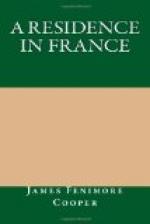LETTER V.
National Guards in the Court of the Palace.—Unclaimed Dead in the Morgue.—View of the Scene of Action.—A blundering Artillerist.—Singular Spectacle.—The Machinations of the Government—Martial Law.—Violations of the Charter.—Laughable Scene in the Carrousel.—A refractory Private of the National Guard.
Dear ——,
The day after the contest was closed, I went to the Louvre, where I usually met Mr. M——, who was busy copying. He was almost alone, in the long and gorgeous galleries, as in the days of the cholera; but we got a view of the National Guards that had been concerned in the affair of the previous day, who were drawn up in the court of the palace to receive the thanks of the King. There could not have been five thousand of them, but all might not have been present.
From the Louvre I went to took at the principal scene of action. A collection of some of the unclaimed dead was in the Morgue, and every one was allowed to enter. There were fifty or sixty bodies in this place, and among them were a few women and children, who had probably been killed by accident. Nearly all had fallen by gun-shot wounds, principally musket-balls; but a few had been killed by grape. As the disaffected had fought under cover most of the time, I fancy the cavalry did little in this affair. It was whispered that agents of the police were present to watch the countenances and actions of the spectators, with a view to detect the disaffected.
As we had several of Napoleon’s soldiers at dinner yesterday, and they had united to praise the military character of the position taken by the revellers, I was curious to examine it. The Rue St. Mery is narrow, and the houses are high. The tower of the church is a little advanced, so as to enfilade it, in a manner, and the paving-stones had been used to make barricades, as in 1830. These stones are much larger than our own, are angular, and of a size that works very well into a wall; and the materials being plenty, a breastwork, that is proof against everything but artillery, is soon formed by a crowd. Two streets entered the Rue St. Mery near each other, but not in a right line, so that the approach along each is commanded by the house that stands across its end. One of these houses appears to have been a citadel of the disaffected, and most of the fighting was at and near this spot. Artillery had been brought up against the house in question, which was completely riddled, though less injured by round-shot than one could have thought possible. The windows were broken, and the ceilings of the upper rooms were absolutely torn to pieces by musket-balls, that had entered on the rise. Some twenty or thirty dead were found in this dwelling.




